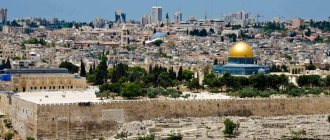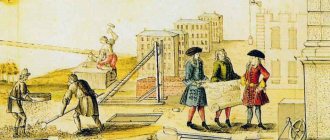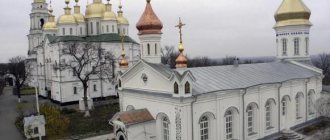JERUSALEM CATHEDRAL OF THE APOSTLES
about which it is known both from the autobiographical message of the ap. Paul in Gal 2.1-10, and from the narrative of the Evangelist Luke in Acts 15.2-21. Both descriptions indicate that a meeting took place in Jerusalem between the apostles Paul, Peter, James, the brother of the Lord, and, according to Gal 2.9, John. The purpose of the meeting is to discuss issues related to the recognition of the mission of the ap. Paul among the pagans and determining the necessary conditions for the acceptance of pagans into Christ. Church. The Council sent a message to pagan Christians in Antioch, Syria and Cilicia. This message is quoted or perhaps expounded in Acts 15:23-29. Most researchers adhere to traditions. t.zr., that in the 15th chapter. book Acts of the Holy Apostles and St. Paul in Gal 2 refers to the same event, namely J.S.a. In this case, I.S. a. took place in 49 or 50. However, such identification of the events described in the Acts of St. apostles and in the Epistle of Galatians, led to the emergence of alternative views: the message of the apostle is identified. Paul about his visit to Jerusalem (Gal 2) with the message from Acts 11.27-30 or from Acts 18.20-22. These no less hypothetical t.s. do not make a significant change to the traditionally accepted, albeit approximate date of I.S. a.
The reason for I.S. a. there were events in the Antiochian Church described in the Acts of St. apostles The first missionary journey of the apostles Barnabas and Paul, which began in Antioch, was accompanied by the success of the gospel preaching among the pagans of the Asia Minor provinces of the Roman Empire. Returning to Antioch, the apostles Barnabas and Paul “told everything that God had done to them and how He had opened the door of faith to the Gentiles” (Acts 14:27). But the success of the apostles became the cause of conflict. “Some who came from Judea taught the brothers: unless you are circumcised according to the rite of Moses, you cannot be saved. When there was a disagreement and considerable competition between Paul and Barnabas and them, they decided that Paul and Barnabas and some others of them should go to the Apostles and Elders in Jerusalem on this matter” (Acts 15. 1-2). In Jerusalem, “some of the Pharisees who believed” came out again (Acts 15:5). They insisted on the need for strict observance of the Law of Moses and demanded the circumcision of Gentile converts. Then “the apostles and elders met together to consider this matter” (Acts 15:5-6).
The events in Galatians are presented somewhat differently. According to the memoirs of Ap. Paul, he, Barnabas and Titus went to Jerusalem “by revelation” (Gal 2. 1-2), and not on behalf of the Antiochian Church. For up. Paul, neither his apostolic authority nor his mission among the Gentiles can be doubted, for both are based on the revelation of God: “The gospel which I preached is not a man’s, for I also received it and learned it, not from man, but by revelation Jesus Christ" (Gal. 1. 11-12). Having received revelation and commission from God, he did not need the sanction of his apostolic activity from Christ. leaders in Jerusalem. “When God, who chose me from my mother’s womb and called me by His grace, deigned to reveal His Son in me, so that I might preach Him to the Gentiles, I did not then consult with flesh and blood, and did not go to Jerusalem to the Apostles who preceded me "(Gal. 1. 15-17). A new journey to Jerusalem ap. Paul did not undertake this to justify his missionary activity. He wanted to present to the Church of Jerusalem his “good news” among the pagans and himself as the “apostle of the pagans” who founded Christ in the pagan world. Churches (Gal 2.2). Purpose of the app. Paul - the establishment of the unity of Christianity through the mutual recognition of the Church in Judea and the Churches he founded in Syria, Cilicia (Gal 1.21) and other places. Ap. It is also important for Paul to recognize his apostolic activity among the Jews and his as an apostle among the Gentiles. He takes with him to Jerusalem Titus, a Greek and uncircumcised (Gal 2.1, 3), as an example of a pagan converted to Christ. In the book. Acts of St. The apostles do not report the presence of Titus in Jerusalem.
In the meeting of the apostles and elders (Acts 15:6), after a long discussion, the opinions of 3 sides were presented. First the ap spoke. Peter, who compared the experience of his own missionary activity, described in Acts 10. 1 - 11. 18, with the results of the mission of St. Paul and actually supported t.zr. last: both Jews and Gentiles are saved by grace through faith, and not by works of the law. “God gave them a testimony, giving them the Holy Spirit, just as He gave us; and made no difference between us and them, purifying their hearts by faith. Why are you now tempting God, [wanting] to place on the necks of the disciples a yoke that neither our fathers nor we could bear? But we believe that through the grace of the Lord Jesus Christ we will be saved, just as they were” (Acts 15:8-11). Then those gathered listened to “Barnabas and Paul telling what signs and wonders God had done through them among the Gentiles” (Acts 15:12). The last to speak was the Lord's brother James, who had great authority in the Jerusalem Church and was the de facto head of the conservative Jewish Christians. He expressed his balanced judgment - “not to make it difficult for those of the Gentiles to turn to God” (Acts 15:19), and it was accepted by the meeting as a general decision.
Ap. Paul does not give any details regarding the specific meetings, but appears to distinguish between 4 groups involved in the discussion. The widest audience was the Jerusalem community itself, ap. Paul presented the Gospel he preached (Gal 2:2a). A narrower group was formed by the “most famous” (possibly disciples of the Apostle Peter - Theoph. Bulg. In epistolam ad Galatas // PG. 124. Col. 969), with whom he had a conversation “separately, in private” (Gal. 2 2b). They did not demand circumcision from Titus (Gal 2:3) and did not impose “nothing more” on the Apostle of the Gentiles (Gal 2:6). The apostle called the third group “false brethren,” who were obviously dissatisfied with their communication with the uncircumcised Titus (Gal 2:4). Finally, crucial for the ap. Paul had the judgment of the 3 most authoritative figures of the Jerusalem Church, whom he calls “pillars.” These are the apostles James, Cephas (Peter) and John (Gal 2.7-10).
Book Acts of St. The Apostles dwells in detail on the decisions of J.S.A., set out in the letter to the Christians of Antioch, Syria and Cilicia (Acts 15. 23-29). These decisions are considered to be the work of the Holy Spirit. The words “according to the Holy Spirit and to us,” which begin the presentation of the decrees (Acts 15:28), became an exemplary formula for subsequent Church Councils. The message refers to the official. recognition by the Jerusalem Church (“apostles, elders and brethren”) of the missionary activity of St. Paul among the Gentiles, subject to the most necessary requirements for the communication of Jewish Christians with Gentile Christians.
Ap. Paul in Gal 2.6-9 lists the results of negotiations with the “famous” and “pillars.” These results are fundamentally the same as in the book. Acts of St. apostles, and differ from the latter only in details. The “famous” did not limit Christ in any way. freedom preached by St. Paul: “The famous have laid nothing more on me” (Gal 2:6b). The “pillars” recognized the equality and mutual complementarity of the missionary tasks entrusted by God to the apostles Peter and Paul (Gal. 2.7). “Pillars”, recognizing the Divine calling of St. Paul (Gal 2.9a), symbolically shook hands with the apostles Paul and Barnabas as a sign of communication (Gal 2.9b). Missionary spheres of activity were divided: the apostles Paul and Barnabas preach the gospel to the Gentiles, and the “pillars” preach to the circumcision (Gal 2.9c). The only condition mentioned is that those apostles who preach to the pagans must “remember the poor” (Gal 2:10), that is, collect donations for the Church of Jerusalem (cf. 2 Cor 8-9).
The messages of the apostles Paul and Luke coincide in that the premise of the discussion that took place at I.S.A. was the recognition of the permissibility of mission among the pagans. The fundamental problems of the entry of pagans into the Church are discussed in detail in Acts 10. 1-11, 18. Both the “false brothers” (Gal. 2. 4) and those who believed “from the Pharisaic heresy” (Acts 15. 5) were ready to accept Gentile Christians at condition of their joining to the covenant of God with Israel, i.e. it was necessary to circumcise the pagans.
In the book. Acts of St. Apostles J.S. a. presented as a turning point and central event in the history of early Christianity. This Council formalized the transition to a universal apostolic mission.
For up. Paul achieved on I.S. a. mutual recognition of the Churches and their communication were of great importance, of course. This is evident from the place he assigned in his missionary activity to “collections for the saints” (Rom 15:14-29; 1 Cor 16:1-4; 2 Cor 8-9; 12:16-18; Gal 2:10 ). However, the communication of Christians from pagans and Jews was determined not by the fact that such communication was legitimized by I.S.A., but by its correct understanding of the Gospel of God: all believers and baptized in Christ constitute one body (Rom 12.5; 1 Cor. -27), in which “there is no longer Jew or Gentile; there is neither slave nor free; there is neither male nor female: for you are all one in Christ Jesus” (in the critical text “one in Christ Jesus” (εἷς ἐστε ἐν Χριστῷ ᾿Ιησοῦ/) - Gal. 3.28). Church for St. Paul is one and universal, since every believer in Christ, regardless of who he was up to that moment, enters it as a free person blessed with grace. Consequently, in the Church, every baptized person, regardless of his origin “by nature” (Gal. 2.15) and his past, is recognized and must be loved: “You, brethren, have been called to freedom...serve one another through love. For the whole law is contained in one word: “You shall love your neighbor as yourself”” (Gal 5:13-14). Therefore, in the description of I.S. a. at ap. Paul is not talking about sanctioning a pagan mission, as is done in the speech of St. Jacob on I.S. a. in Acts 15.19, but exclusively about mutual fraternal recognition, since the very apostleship of Paul and his mission among the pagans are based not on the decisions of J.S.A., but on the Revelation of God (Gal. 1.12, 16).
According to the book. Acts of St. apostles, J.S. a. ended with the decision to send to Antioch with the apostles Paul and Barnabas “Judas, called Barsaba, and Silas, men in charge among the brethren,” handing them a message from J.S. Christians of Antioch, Syria and Cilicia (Acts 15.22-29). In biblical studies this letter is often called the “Apostolic Decree.” This letter is to communicate the decision made by the apostles and elders in agreement with the whole Church (Acts 15:22). The content of the message reflects the proposal of the apostle. James: not to place on pagan Christians “any burden more than this necessary: to abstain from things sacrificed to idols, and blood, and things strangled, and fornication” (Acts 15:20, 28-29). T.n. "Western" text of the book. Acts, to which Russian also goes back. The synodal translation adds ethical requirements to these conditions, in particular the “golden rule” - not to do to others what they do not want to do to themselves. Circumcision is not mentioned among the conditions, since its optionality for the Gentiles is implied in Acts 15. 19, 28: “not to make it difficult for those of the Gentiles to turn to God.” This means not requiring them to be circumcised. Resolution of I.S. a. solves the problem as it is presented in Acts 15. 1, 5 and in the conciliar speech of St. Peter (Acts 15:7-11). This problem consisted of the fundamental possibility for the Old Testament tradition of the entry of pagans into the Church of God. On the one hand, the decisions of I.S. a. had to satisfy the very minimum requirements of the Law of Moses, on the other hand, they had to open up the possibility of communication with Christians from Jews for Christians from the Jews and facilitate the mission among the pagans in general. In connection with the conditions formulated in Acts 15. 28-29, a compromise solution to the problem was proposed. They demanded compliance with the instructions of Lev 17-18. Firstly, all participation in pagan sacrifices was prohibited (Lev 17:7-9), including eating “sacrificed to idols,” that is, meat left over from pagan sacrifices. Secondly, eating blood and strangled meat was prohibited (Lev 17:10-14). These 2 prohibitions actually represented 1 requirement, since “strangled” meant the meat of animals killed without bleeding. “Abstinence from fornication” also meant the prohibition of consanguineous marriages and sexual perversion (Lev 18:6-30). That. the possibility of communication (primarily at meals) of circumcised Christians with uncircumcised Christians was guaranteed (see: Lev 17. 1-16).
At the same time, ap. Paul, whom the “Apostolic Decree” was supposed to concern in the first place, does not mention it. Moreover, his description of the meeting of the apostles and its results seems to exclude the existence of such an agreement (Gal. 2. 6-10). Reasoning and argumentation of the ap. Paul regarding sacrifice to idols (1 Cor 8-10; Rom 14. 1 - 15. 13) would have been unnecessary if he had known or recognized this document. The only place in the NT that may contain a hint of the “Apostolic Decree” is Rev. 2.24. Therefore, in critical biblical studies the question of the historicity of the “Apostolic Decree” was raised and still remains open.
The further history of Christianity showed that the literal content of the resolution of I.S. had temporary significance. It presupposed “a certain balance of Jewish and pagan elements in the Church. With the spread of Christianity among the pagans, this balance was increasingly disturbed in favor of Christians of pagan origin" (Cassian (Bezobrazov). 1950. p. 166). For Jewish Christians, liberation from the law was an inevitable consequence of the destruction of the Jerusalem Temple in 70 AD.
Lit.: Cassian (Bezobrazov), bishop. Christ and the first Christian generation. P., 1950. S. 163-166; Dibelius M. Aufsätze zur Apostelgeschichte. Gött., 19614. S. 84-90; Conzelmann H. Die Apostelgeschichte. Tüb., 1963; Haenchen E. Die Apostelgeschichte. Gött., 1968. S. 396-414; Catchpole DR, Paul, James and the Apostolic Decree // NTS. 1977. Vol. 23. N 4. P. 428-444; Strobel A. Das Aposteldekret als Folge des antiochenischen Streites // Kontinuität und Einheit: Für F. Mussner. Freiburg i. Br., 1981. S. 81-104; Hahn F. Die Bedeutung des Apostelkonvents für die Einheit der Christenheit einst und jetzt // Auf Wegen der Versöhnung: Beitr. z. ökumenischen Gespräch. Fr./M., 1982. S. 15-44; Weiser A. Das Apostelkonzil // BiblZschr. 1984. Bd. 28. N 2. S. 145-168; Radl W. Das Gesetz in Apg 15 // Das Gesetz im NT / Hrsg. K. Kertelge. Freiburg i. Br., 1986. S. 169-175; Boismard M.-E. Le “Concile” de Jérusalem // EthL. 1988. Vol. 64. N 4. P. 433-440; Böcher O. Das sogenannte Aposteldekret // Vom Urchristentum zu Jesus: Für J. Gnilka. Freiburg i. Br., 1989. S. 325-336; Schmidt A. Das historische Datum des Apostelkonzils // ZNW. 1990. Bd. 81. N 1/2. S. 122-131; Schmithals W. Probleme des “Apostelkonzils” (Gal 2. 1-10) // Hervormde teologiese studies. Pretoria, 1997. Bd. 53. S. 6-35; Kliesch K. Apostelgeschichte. Stuttg., 2002. S. 102-108; Vouga F. Urchristentum // TRE. 2002. Bd. 34. S. 416-417, 425-427; Brown R. Introduction to the New Testament. M., 2007. T. 1. P. 337-341.
Archim. Iannuariy (Ivliev)
Church of the Holy Sepulcher in Jerusalem. Plan
1 – Holy Sepulcher, 2 – Angel’s Chapel, 3 – Sepulchers of Joseph and Nicodemus, 4 – Place of the Appearance of Christ to Mary Magdalene, 5 – Franciscan Chapel of the Flagellation, 6 – Church of the Resurrection (Katholikon) of the Jerusalem Patriarchate, 7 – Place of the Appearance of Christ to His Mother after Resurrection (Catholic tradition), 8 – Place where the Cross of the Lord was recognized (Catholic tradition), 9 – Catholic sacristy, 10 – Chapel of the Blessed Virgin Mary, 11 – Chapel of the Prison of the Lord, 12 – Chapel of Longinus the Centurion, 13 – Niche with a flagellation column, 14 – Chapel of the Dividing of the Robes of the Lord, 15 – Chapel of the Crown of Thorns, 16 – Underground Church of Queen Helena, 17 – Place where the Cross of Golgov was found, 18 – Chapel of Abraham (John the Baptist), 19 – Office of the Greek Patriarchate, 20 – Repository of Shrines, 21 – Staircase of Mary of Egypt (entrance walled up), 22 – Stone of Anointing, 23 – Staircase to Golgotha, 24 – Sorrowful Way, 25 – Place where the Myrrh-Bearing Wives stood during the Crucifixion, 26 – Entrance to the Temple.








